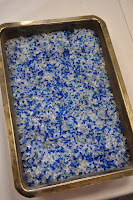This past
weekend, conservators from all over Turkey traveled to the Japanese Institute
of Anatolian Archaeology to attend the 2019 Kaman Conservation Symposium. The
two-day symposium began with a tour of the excavation site at Kaman-Kalehöyük
led by Dr. Öğr. Üyesi Kimiyoshi Matsumura, followed by a visit to the
Kaman-Kalehöyük Archaeological Museum. Conference attendees then made their way
back to the Institute, pausing to appreciate the beauty of the Japanese
Memorial Garden.
 |
| Visiting the North Trench at Kaman-Kalehöyük. |
 |
| Stopping by the koi pond at the Japanese Memorial Garden before a day of talks and discussion. |
Dr. Sachihiro
Omura, Director of the JIAA delivered the welcoming remarks. He spoke of the
importance of having a dedicated conservation team at Kaman, and emphasized how
the JIAA’s studies of the site have been enriched by having conservators and
archaeologists working together. The rest of the symposium consisted of a
variety of thought-provoking talks centered around collaborative work completed
by the speakers at archaeological sites and museums in Turkey. Attendees also
had the chance to tour the JIAA and visit various laboratories including
conservation, paleoethnobotany, zooarchaeology, and physical anthropology.
A total of 25
people attended the symposium. In addition to the invited speakers,
archaeologists, anthropologists, and student interns participating in the 2019
field season at Kaman were able to attend the talks and participate in the
lively discussions that followed. We owe a special thanks to archaeology student
intern Zeynep Kuşdil for providing translation for speakers who gave their
talks in Turkish.
This symposium
was an excellent venue for conservators working within Turkey to share their
experiences and discuss solutions for issues they face at their respective
workplaces, including where to locate conservation supplies and methods for
stabilizing crumbling mudbrick structures.
A list of talk titles and speakers can be found below:
- A New Era in Conservation: Processual Restoration – Conservation - İlkay İvgin
- Cultures of Collaboration at Sardis - Brian Castriota and Sarah Montonchaikul
- Wall Painting Conservation in Archaeological Sites - Prof. Dr. Bekir Eskici and Arş. Gör. Dr. Berna Çağlar Eryurt
- How ‘the Evidence of Past Human Activity' was Lifted from its Context - Barcın Höyük, Bursa - Evren Kıvançer and Rana Özbal
- Architectural Remains, Conservation Problems and Solution Suggestions in the Archeological Excavations - Yaşar Selçuk Şener
- Archaeometric Analyses of Kaman Yassihöyük Adobes and Conservation Problems - Tuğba Dirican and Ali Akın Akyol
- Some Trials on Chemical Consolidation of Archaeological Mudbrick Walls - Marianne Rochebeuf (Presented by Alice Paterakis)
- Analysis, Restoration and Conservation of Lydian Metal Artifacts from Uşak Museum (The Treasury of Croesus) - Latif Özen, Abdullah Zararsiz and Mahmut Aydin
- Conservation Practices of Archaeological Metal Finds: Case Studies from Excavation, Museum and Laboratory - Uğur Genç and Bengin Bilici
- Collecting In-situ and Laboratory Data on Corroded Metal Artefacts - Ian D. MacLeod
- Oxygen Absorbers and Desiccants in the Protection of Archaeological Metals - Alice Boccia Paterakis
- Preventıve Conservation Methods for Ceramıc Objects in Exhibitions - Serkan Gedük (Presented by İlkay İvgin)





















